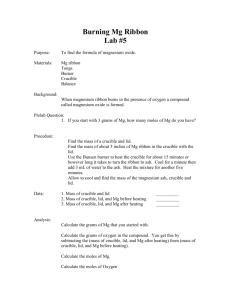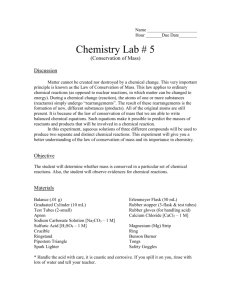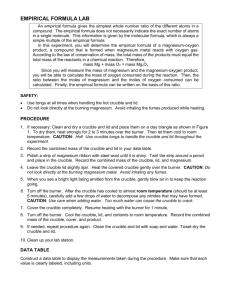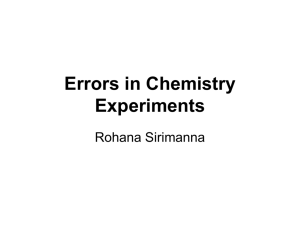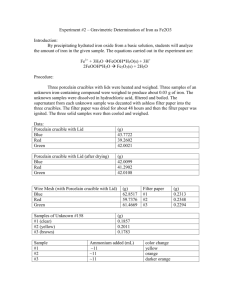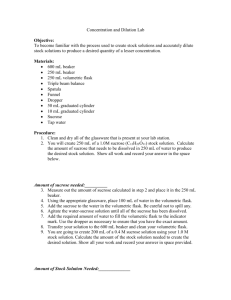DETERMINING AN EMPIRICAL FORMULA Introduction The
advertisement
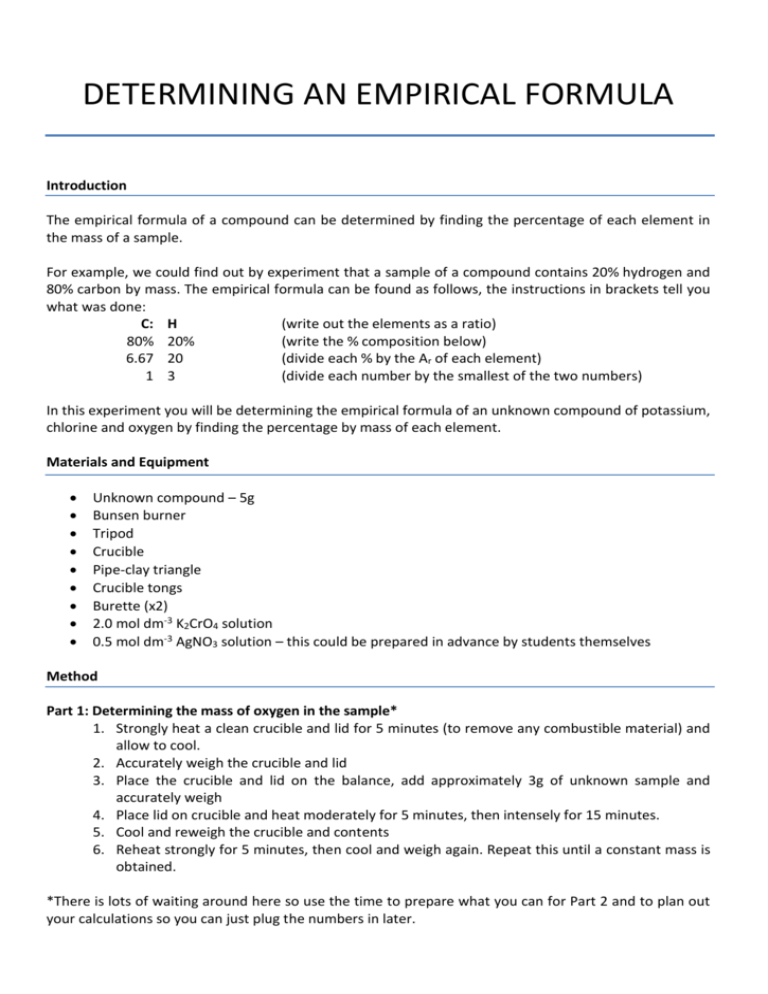
DETERMINING AN EMPIRICAL FORMULA Introduction The empirical formula of a compound can be determined by finding the percentage of each element in the mass of a sample. For example, we could find out by experiment that a sample of a compound contains 20% hydrogen and 80% carbon by mass. The empirical formula can be found as follows, the instructions in brackets tell you what was done: C: H (write out the elements as a ratio) 80% 20% (write the % composition below) 6.67 20 (divide each % by the Ar of each element) 1 3 (divide each number by the smallest of the two numbers) In this experiment you will be determining the empirical formula of an unknown compound of potassium, chlorine and oxygen by finding the percentage by mass of each element. Materials and Equipment Unknown compound – 5g Bunsen burner Tripod Crucible Pipe-clay triangle Crucible tongs Burette (x2) 2.0 mol dm-3 K2CrO4 solution 0.5 mol dm-3 AgNO3 solution – this could be prepared in advance by students themselves Method Part 1: Determining the mass of oxygen in the sample* 1. Strongly heat a clean crucible and lid for 5 minutes (to remove any combustible material) and allow to cool. 2. Accurately weigh the crucible and lid 3. Place the crucible and lid on the balance, add approximately 3g of unknown sample and accurately weigh 4. Place lid on crucible and heat moderately for 5 minutes, then intensely for 15 minutes. 5. Cool and reweigh the crucible and contents 6. Reheat strongly for 5 minutes, then cool and weigh again. Repeat this until a constant mass is obtained. *There is lots of waiting around here so use the time to prepare what you can for Part 2 and to plan out your calculations so you can just plug the numbers in later. Part 2: Determining mass of chlorine in the sample 1. Transfer the residue from Part 2 to a clean, dry beaker and add approximately 50 ml distilled water. 2. Wash the crucible with a little distilled water and transfer the washings to the beaker 3. Stir beaker contents thoroughly until dissolved and transfer (using a funnel) to a 250 ml volumetric flask 4. Wash the beaker with distilled water and transfer the washings to the volumetric flask. 5. Make up volume in flask to 250 ml, place on the lid and invert several times to mix thoroughly 6. Use a bulb pipette to transfer 25.0 cm3 of your sample solution to a 100 ml conical flask 7. Add 10 drops of potassium chromate indicator to the flask. 8. Titrate with silver nitrate solution (ideally the one prepared in the ‘solutions’ lesson) until a permanent slight pink/red tinge remains 9. Repeat until two titres are obtained in close agreement (within 0.1 ml) Calculations 1. Calculate mass of oxygen released and hence the percentage by mass of oxygen in your initial sample 2. Calculate the number of moles of silver nitrate in your average titre and use this to determine the number of moles of chloride in a 25 ml sample (hint Ag+ ions and Cl- ions react 1:1) 3. Determine the number of moles of chloride in your 250 ml volumetric flask 4. Determine the mass of chloride in your volumetric flask and hence the % by mass in the sample 5. By deduction, determine the % by mass of potassium in your sample 6. Determine the empirical formula of the unknown compound Notes: The unknown compound is potassium chlorate (KClO3)

